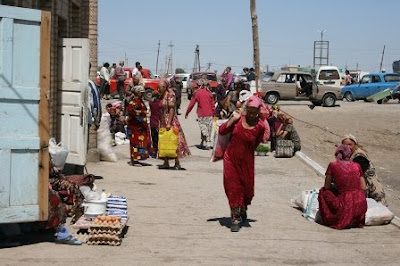






The road was not too bad and arriving in the town of Moyneq we were greeted by the rusting town sign with a jumping fish emblem and all. The little town could have been any fishing village with lime white walls blue roofs and windowsills, nearly abandoned now the only form of income is cotton crops which grow studded in the arid soil the irony being what destroyed the town so long ago is now their only income. We had not been here before and did not know what to expect but it will definitely be another stop next year, again the photos tell the story better than I ever could.









Not far from the sunbaked harbour we found a reservoir and shelter from the wind that whips tons of dust into the sky from the parched ground. The locals sat and stared at us as we stared out over the incredible scenery.



 We all left with a feeling of wonder – a beautiful place with such a sad story, a desert littered with sea shells and rusting hulks and struggling people.
We all left with a feeling of wonder – a beautiful place with such a sad story, a desert littered with sea shells and rusting hulks and struggling people.The group at the Aral Sea - an Odyssey First!
 So from Moyneq we headed for Nukus the former capital of Karikalpakstan we found a bush camp with a twist just before the main centre. As most of this area is planted to crops we drove down a farm road and asked a the lady of the house if we were welcome to stay and much to our delight we spent the night in the farm yard with our local guide making us Plov a traditional rice dish. The girls had a go at cotton field weeding which was as rubbish as it sounds while the boys dug in the loo and shower as we made ourselves at home.
So from Moyneq we headed for Nukus the former capital of Karikalpakstan we found a bush camp with a twist just before the main centre. As most of this area is planted to crops we drove down a farm road and asked a the lady of the house if we were welcome to stay and much to our delight we spent the night in the farm yard with our local guide making us Plov a traditional rice dish. The girls had a go at cotton field weeding which was as rubbish as it sounds while the boys dug in the loo and shower as we made ourselves at home.



Into Nukus the next morning early I sorted out a few paper work problems with the truck while the group went to the Stavotsky art Museum, Nukus ‘s only claim to fame. During the Soviet era art was tightly controlled and works that were not deemed fit for the public eye were either destroyed or, luckily, sent to be locked away in Nukus, they now have some 90,000 pieces, a selection of which you can view over the four floors of this incredible art museum.
Back on track we started our tour of the silk road cities. Khiva the smallest of the lot gives you a taste of the incredible architecture and history of the Silk Road, a full day tour conducted by our local guide gives the full story.We stayed in a small family run hotel and after our adventures in Kazakhstan, the air-conditioned rooms dotted around a central court yard were a welcome relief! That night we had a group meal of local delicacies and a show normally saved for weddings preformed by an Uzbek Dancing family.
From Khiva it was off to Bukhara, another incredible Silk Road city.












 And them off to Samerkand. In each city we supply a tour that you may join for the entire day or just a morning, there is so much to take in you actually have to have the occasional break and check your mails in the internet cafe or sit and read a book. The Registan Square is the most decorative of the all the Silk Road cities and is a sight to wonder at.
And them off to Samerkand. In each city we supply a tour that you may join for the entire day or just a morning, there is so much to take in you actually have to have the occasional break and check your mails in the internet cafe or sit and read a book. The Registan Square is the most decorative of the all the Silk Road cities and is a sight to wonder at.




No comments:
Post a Comment